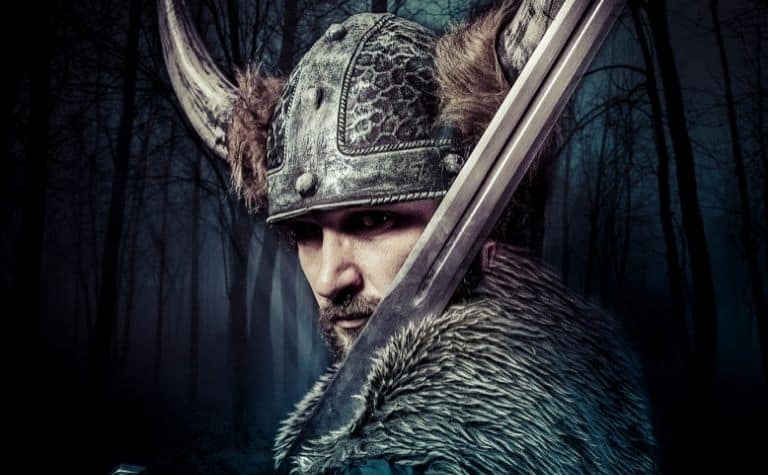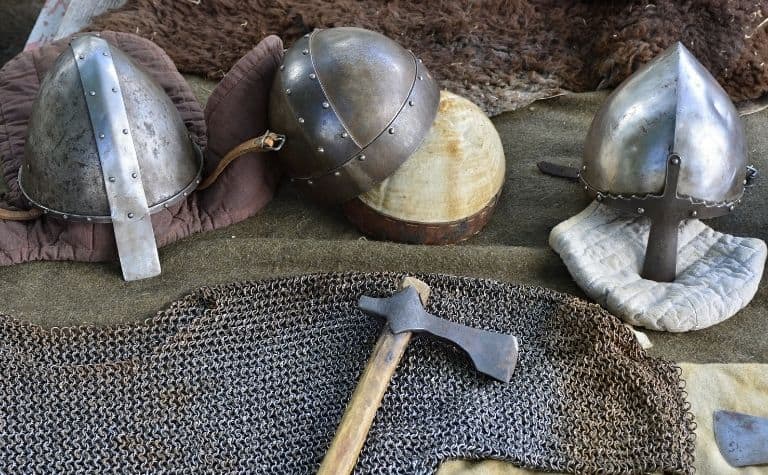The Vikings are among the most legendary figures in the history of humankind, with a two-and-a-half-century-long reign during the Middle Ages.
When thinking about the Vikings, many things come to mind: their majestic longboats, fierce warrior spirit, and many conquests throughout Northern Europe.
But one iconic image of the Vikings is completely wrong.
The Vikings did not have horns on their helmets, at least not the helmets they wore to battle.
So few Viking-age helmets have been found at all that there is reason to believe that not many Vikings wore them, and if they did, theirs were basic, protective headgear fashioned from iron or leather.
Despite the historical inaccuracy of Vikings wearing helmets with horns strikingly adorning the sides, they are a common feature in contemporary depictions of these Norse warriors in everything from film and television to video games.
Horned helmets are as much a part of the Viking mystique as their long manes of hair and scraggly beards, and for this, the world has a 19th-century costume designer to thank. Keep reading to learn more.
Also see The Seax: A Viking Weapon to learn more.

Where did the Vikings’ horned helmet originate?
To date, very few Viking-age helmets have been recovered by archeologists, and most of them consist of fragments.
The one complete helmet to be discovered thus far (more on this later), verified by historians as Viking in origin, was recovered from a warrior’s grave in Gjermundbu, Norway, and horns were noticeably absent from this headgear.
Norse poems and sagas are often looked to by Viking scholars for insight into the lives of Vikings, and not one makes mention of horned helmets.
Depictions from the Middle Ages of Vikings wearing headgear resembling helmets also lack horns.
So, where did the idea of Vikings’ horned helmets start? Here are the most likely sources for this historical inaccuracy:
- Costume designer Carl Emil Doepler famously incorporated horned helmets into the costumes worn by the Viking characters in Wagner’s opera Der Ring des Nibelungen during the late 19th century and scholars believe this is the likeliest source of the captivating, albeit completely false, notion that the Vikings wore helmets with horns on them
- Swedish artist Gustav Malmstrom depicted the Vikings in full regalia, including horned helmets in his collection of illustrations titled Frithiofs Saga published in the 1800s
- European Christians who encountered the Vikings may be responsible for embellishing descriptions of the Norse raiders as wearing helmets with horns on them to portray them in an unflattering manner (i.e., devils with horns) [1]
In addition to the aforementioned theories regarding the origin of the Viking horned helmet, several historically based-possibilities are worth considering:
- At the famous Oseberg Viking burial site in Norway, among the archeological riches that were recovered was a tapestry depicting Norse warriors donning horned helmets [2]
- The so-called Golden Horns, originally discovered in 1639 and 1734 in modern-day Denmark, were believed to have been crafted as far back as the year 400 AD, and among the intricate carvings are depictions of warriors wearing helmets with horns on them [3]
While there are possible indications that the Vikings may have worn horned helmets for ceremonial purposes, these items had no practical role whatsoever in their everyday lives.
And in any combat or conflict scenario, helmets with horns would have been the last thing that any Viking in his right mind would have chosen to wear:
- In hand-to-hand fighting, horns sticking out of a helmet would have been too easy for an enemy soldier to grab hold of or for a sword or axe to get caught up against [4]
- As a practical matter, horns (or anything else protruding from a helmet) could easily become entangled in branches, brush, or any other obstacle during long marches or clandestine maneuvers [5]
Not only would horned helmets have been cumbersome for the Vikings to wear, but they could also have posed a danger to fellow warriors in tight quarters aboard longships with their pointed tips.
Also see Did the Vikings Have Slaves? to learn more.

What did Viking helmets really look like?
Just like other aspects of Viking life that have turned out to be more practical, if not mundane, than myth and legend typically portray them, the helmets worn by the Vikings were very purpose-built.
Scholars seem to agree that as far as Viking helmets go, the emphasis was on function over aesthetics, the former being head protection during combat and the latter being purely decorative features like horns.
Based on the Gjermundbu helmet, the only fully intact specimen ever recovered, along with depictions believed to be accurate in their representation of helmets worn by the Vikings, these are the known attributes of the helmets that the Vikings actually wore:
- Viking helmets were dome-shaped and likely covered the entire upper half of warriors’ heads to protect them from blows from enemy weapons like swords, axes, arrows, and spears
- Built-in plates or ridges were incorporated into the front of the helmet to protect the eye and brow areas
- The Gjermundbu helmet also featured a vertical finger-like piece dropping down from the forehead to protect the bridge of the wearer’s nose [6]
Also see What Language Did the Vikings Speak? to learn more.
Did Vikings wear metal helmets?
Horns aside, strong archaeological evidence establishes that the Vikings did wear metal helmets.
The Gjermundbu helmet was recovered from a Viking warrior’s grave in Norway and is indicative of the prototypical design used by the Vikings in designing and constructing their metal helmets:
- The Vikings fashioned metal helmets from pieces of iron riveted together
- Fabrication typically started with a band of iron that would encircle the wearer’s head, followed by two strips that would intersect at the crown of the head or top of the skull
- The four resulting openings would then be covered by shaped iron plates which were riveted into place (or as a less expensive alternative, thick pieces of leather could be used)
- To protect the eyes and nose, additional pieces of iron would be riveted to the front of the helmet
- It is presumed that some sort of cushioning inside the helmet was necessary to prevent the incredible energy from direct blows to the iron material from transferring directly to the wearer’s skull (leather or sheepskin may have served this purpose) [7]
The fact that so few metal helmets have been recovered from Viking burial sites has perplexed scholars and historians.
One popular theory is that metal helmets were extremely rare among the Vikings due to the exorbitantly high cost of the materials and the skilled craftsmanship required to make them.
Therefore, only wealthy and powerful Vikings could afford to own one.
Experts believe that the majority of Vikings who donned helmets likely wore head coverings made from leather, as they were far more affordable and easier to produce. [8]
The choice of leather would also explain why so few Viking helmets have been recovered from burial sites, as this material would not survive centuries buried in the ground.
Another possibility is that most Vikings, either by choice or by financial circumstances, simply fought without any type of helmets at all.
What is the Viking helmet with horns called?
There are several competing theories on how the mythical and historically inaccurate Viking horned helmet came into being.
However, the one that seems to garner the most votes among scholars and historians involves German costume designer Carl Emil Doepler and the captivating wardrobe pieces he designed for Wagner’s operatic depiction of Norse characters that would become cultural icons. [9]
While there is no official technical or historical term for the Viking helmet with horns, the Doepler helmet would certainly be fitting, and in its own way, historically accurate. [10]
Conclusion
The Vikings are larger-than-life figures whose fame and notoriety may be greater now than ever before, with or without horns on their helmets.
References:
[1] Source
[2] Source
[3] Source
[4] Source
[5] Source
[6] Source
[7] Source
[8] Source
[9] Source
[10] Source
